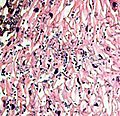Esophageal candidiasis: Difference between revisions
CSV import |
CSV import Tags: mobile edit mobile web edit |
||
| Line 26: | Line 26: | ||
{{stub}} | {{stub}} | ||
<gallery> | |||
File:Esophageal_candidiasis_(1)_PAS_stain.jpg|Esophageal candidiasis (1) PAS stain | |||
File:Esophageal_candidiasis_(2)_PAS_stain.jpg|Esophageal candidiasis (2) PAS stain | |||
File:Esophageal_Candidiasis2010.JPG|Esophageal candidiasis | |||
File:Candida.jpg|Candida | |||
</gallery> | |||
Revision as of 04:58, 18 February 2025
Esophageal candidiasis is a fungal infection of the esophagus, the tube that carries food from the mouth to the stomach. It is caused by the yeast Candida species, most commonly Candida albicans. This condition is often seen in people with weakened immune systems, such as those with HIV/AIDS, cancer patients undergoing chemotherapy, or people who have had organ transplants.
Causes
Esophageal candidiasis is caused by the overgrowth of Candida yeast in the esophagus. This can occur when the body's immune system is weakened or when the normal balance of bacteria in the body is disrupted. Certain medications, such as antibiotics or corticosteroids, can also contribute to the development of this condition.
Symptoms
The most common symptoms of esophageal candidiasis include difficulty swallowing, pain when swallowing, and chest pain. Some people may also experience nausea, vomiting, or a feeling of food being stuck in the throat.
Diagnosis
Esophageal candidiasis is typically diagnosed through a procedure called an endoscopy, in which a thin, flexible tube with a light and camera at the end is inserted into the esophagus. A small sample of tissue may be taken for laboratory testing to confirm the diagnosis.
Treatment
Treatment for esophageal candidiasis typically involves antifungal medications, such as fluconazole or itraconazole. In severe cases, hospitalization may be required.
Prevention
Prevention of esophageal candidiasis involves maintaining a healthy immune system and avoiding behaviors that can disrupt the body's natural balance of bacteria. This can include avoiding unnecessary use of antibiotics, maintaining good oral hygiene, and eating a balanced diet.






